My son is five years old this school year and I decided at the beginning of the year to include science into our curriculum plans. We had done lots of Charlotte Mason style nature studies in his preschool years, but I wanted to be a little more formal this year. At the same time, I wanted something simple enough that it wouldn’t be too daunting for a kindergartener.
Being a classical homeschooler, I decided to take the advice of The Well Trained Mind and I bought the Kingfisher first Encyclopedia of Animals. Two times a week we would read about a different animal. When time permitted, I would go to the library and find simple, living books about the animals for the week to read in addition to the page in the Kingfisher encyclopedia. Then I created some Animal Kingdom Notebooking Pages to fill out about the animals. It was a really nice rhythm of reading together (which my kids really enjoy) and then documenting a bit about what we learned.
Then my son started asking for experiments.
Multiple times a week my son would come up to me and say “Let’s do an experiment!” or “Mom, I’m in the middle of an experiment.” I liked what we were doing, but I knew that it was the time for a bit more. Now, to figure out what that little bit more would be. I could just get some experiment books from the library, but I have a hard time with random learning like that.
About that time, Paige from Elemental Blogging linked up one of her posts to my weekly classical homeschooling link-up, Trivium Tuesdays. I really enjoyed the post she shared, and upon browsing her website a bit, I discovered that she has a science curriculum called Elemental Science.
Elemental Science has multiple curriculum options, but the one that piqued my interest was the Classic Series which loosely goes along with the recommendations of The Well Trained Mind. I don’t follow much of the curriculum recommendations from The Well Trained Mind, but I was already using the book recommended for 1st grade science, and that was also the main text of the Biology for the Grammar Stage curriculum from Elemental Science, plus it included experiments!
I knew that this would be just what we needed. I loved that I wouldn’t have to switch anything up (that makes me twitchy =) and that it would provide a relevant experiment or demonstration for each week’s reading. I emailed Paige and asked her if I could review the Biology for the Grammar Stage curriculum. I was excited when she said yes!
What is Biology for the Grammar Stage?
Biology for the Grammar Stage covers three main topics: Animals, the Human Body, and Plants. We were in the middle of our study of animals, so that is where we started! The curriculum includes a teacher’s guide, a student workbook, and optional extras like coloring pages and lapbook templates. Since I already had notebooking pages made up for my son, we started slowly by just adding in the recommended experiments and also following the schedule laid out in the teacher’s guide. This was a really good transition for me. My son was happy because we were doing experiments and I was happy because there were no drastic changes =)
After a few weeks I decided that I wanted to use the curriculum just as it was designed, so we moved on to starting the Human Body Unit. This time, I printed out all pages in the student workbook (I have the ebook version, but there is also a print version available) and bound them up into a notebook for my son. The Student Guide has a notebooking page and a lab report page for each week (plus some other goodies). Then I printed out all the coloring pages and put them into a notebook for my 3 year old daughter so she would feel like she was included in the studies. Here’s a peek inside the Student Guide and the Coloring Book:
Each week we spend two days studying science. I really like that the curriculum gives lesson plans for both a two-day-a-week and a five-day-a-week schedule. I love that it is mostly open and go, once you have a few materials. Here is what you need:
- The recommended encyclopedia for the unit (like the Kingfisher one I mentioned already)
- The recommended experiment book for the unit
- The student notebook
- Any supplies needed for the experiment that week.
- Optional – extra books from the library on t he subject
We do science on Tuesdays and Thursdays, so on Monday morning I take a look at the Teacher’s Guide and see what we will be learning about that week. The Teacher’s Guide provides the basic things you will need to cover for the week and then provides lots of other extra ideas to choose from if you want to take the lesson further. This is really nice because it makes the curriculum adaptable for multiple ages. Here is what is included in the Teacher’s Guide for each week:
- Supply list for the experiment or demonstration
- Instructions for the experiment (or a description and a page number if the experiment is found in the recommended experiment book)
- Explanation of what happened in the experiment
- A Take It Further section for older (or eager) students
- Reading assignment from the recommended encyclopedia
- Discussion Questions
- A list of optional additional books to look for at your library
- Instructions for the narration page
- Instructions for the (optional) Lapbook element
- Vocab word with definition
- Projects that you work on a bit each week throughout the unit
- Extra (optional) projects for the week
- A poem to memorize throughout the course of the unit
- A quiz
- 2-day-a-week and 5-day-a-week lesson plans
Isn’t that a ton?! Being that I have a three and five-year-old, we don’t choose to do all of the above, but I pick a reading selection and activity of some sort out of all those options for each day. Here is what our typical week looks like:
Day 1
- Read a book (or passage) about the topic for the week
- Introduce vocab word and add it to our memory box
- Do the experiment, including filling in the lab report page
- Do a coloring page
Day 2
- Read another book if we have time
- Review the vocab word
- Fill in our notebooking page
- Add a part to our Human Body Project (we decided to make ours life-sized!)
- Do another coloring page if desired
Here is my son adding a muscle to his ‘body’ and my three-year-old daughter proudly standing beside hers!
Here they are learning about the five senses:
If you are looking for a science curriculum for next year, I completely recommend Elemental Science. This biology curriculum has been great, but there are lots of other options too! Here are some you might want to check out:
- Earth Science & Astronomy for the Grammar Stage
- Chemistry for the Grammar Stage
- Physics for the Grammar Stage
- Biology for the Logic Stage
- Earth Science & Astronomy for the Logic Stage
- Chemistry for the Logic Stage
- Exploring Science (K4)
- Intro to Science (K5)
- Living Books – The Sassafras Twins
This post has been written by Amy from Living and Learning at Home and Classical Copywork.
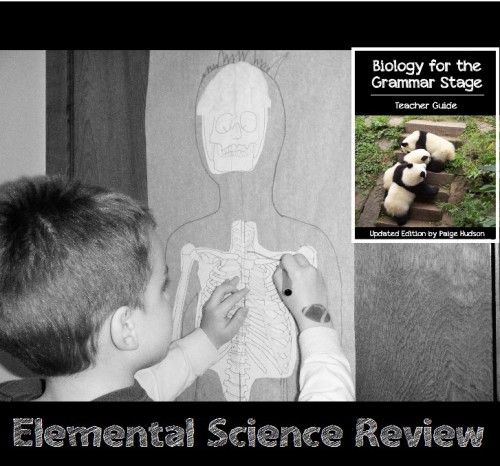
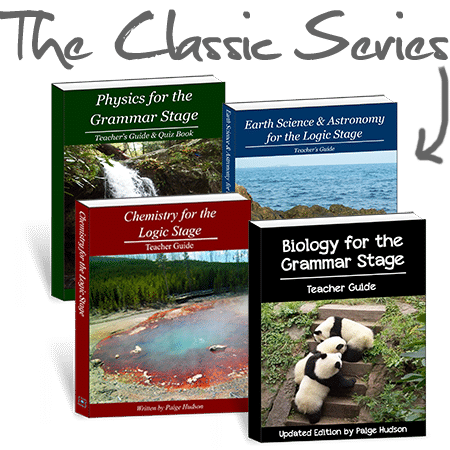
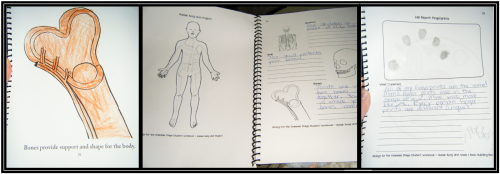
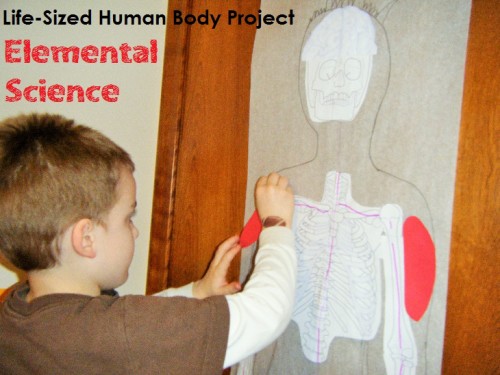

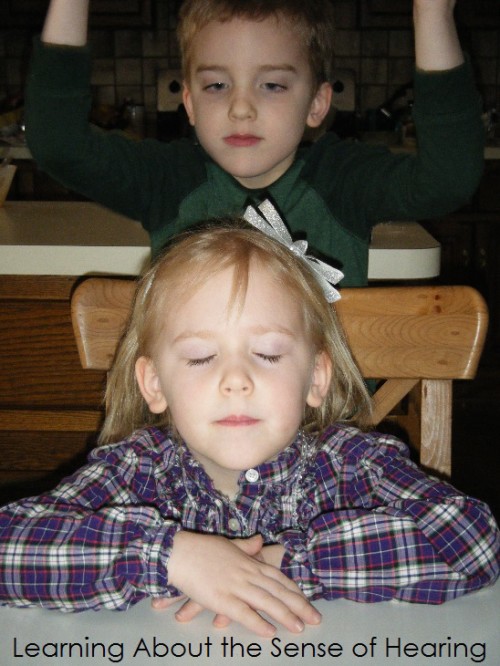
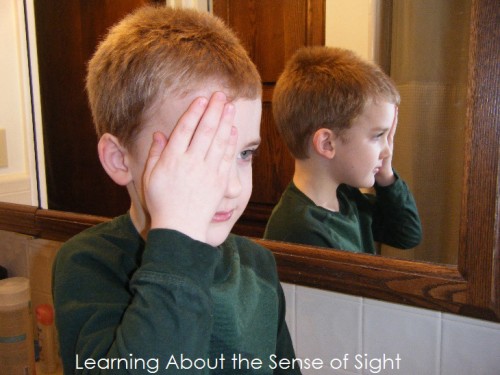

Hello,
how can I get a copy of the skelten, used and the one you used for the circulartory system?
Here is the link to the skeleton. I just googled a picture of a heart for the circulatory system (I don’t remember which one I used).
http://www.spelloutloud.com/human-body-learning-about-bones.html
Hi! I am wondering if you continued with them for the second year in Science? I am a little bit torn on my decision… My kids learned about plants this year (maybe not so organized as in this curriculum), some cytology, some anatomy, but not animals (well, just habitat and what it is). I don’t know if I should review all these with the Biology for Grammar Stage or just move on to the second year with Earth Science.
Another question I had: did you purchase their lap book by any chance? Would I miss out if I don’t get? My kids love doing lap books for their literature class, but I see that a child’s workbook here already has some coloring and projects to do, so I wonder if a lap book would be too much… Or not?